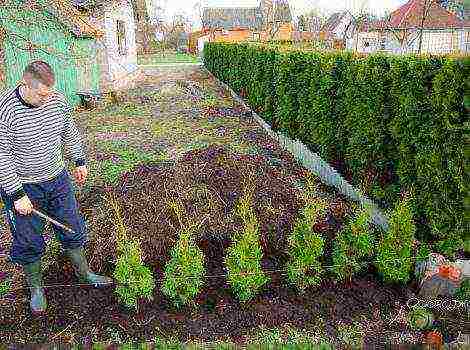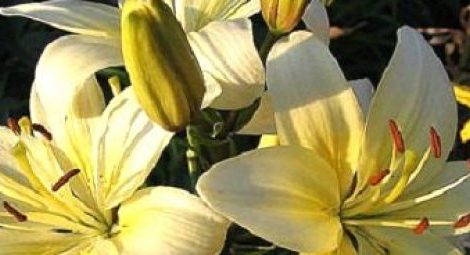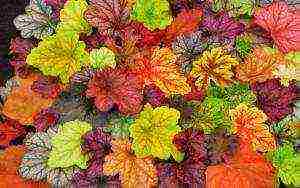Content
Chrysanthemum maiden is a perennial plant that delights with its beautiful chamomile flowering regardless of conditions. The plant is quite unpretentious, but, despite this, it has not only natural rustic beauty, but also useful properties.
Description of the variety
The maiden chrysanthemum is a member of the Astrov family. The plant has a herbaceous structure and is considered perennial. This variety of chrysanthemums has several names, and each of them is quite common: "Chamomile maiden", "Matricaria exclusive", "Tanacetum", "Feverfew maiden".

Chrysanthemum maiden
The height of this plant can reach 70 cm. The leaves have a pinnately dissected shape and attract with their pleasant fragrant aroma. The inflorescences are very small (about 3 cm in diameter). Flowering is combined in separate groups into a kind of umbrella-shaped shields.
The structure of the inflorescences is simple: small baskets of regular shape and white color, complemented by a prominent yellow middle. The flowering period is very long: the beginning, as a rule, in June or July, and the end - during the first autumn frosts.
The fruits of the plant are represented by ribbed seeds, thanks to which the maiden chrysanthemum reproduces.
As already mentioned, this variety is completely unpretentious and can grow, as well as delight with its flowering, even without proper care.
Chrysanthemum maiden is an unpretentious, abundantly flowering plant.
Beneficial features
Not everyone knows that chrysanthemum maiden has a lot of useful properties. Its name comes from the fact that its action is able to relieve pain that occurs in girls during menstruation. And in ancient times, a decoction of this miraculous plant was used as a pain reliever during childbirth.
In addition, this plant has anti-inflammatory and antipyretic properties. But that's not all of its useful characteristics. Chamomile maiden has long been used for household needs.
Chrysanthemum maiden amazes with its supply of nutrients that can relieve pain, relieve inflammation.
Planting methods
The maiden chrysanthemum reproduces by seeds. Sowing of the collected seeds is carried out from March to April in indoor or greenhouse conditions to obtain seedlings. But sowing directly into the ground is also often carried out. For this, the most suitable period is April.

Blooming chrysanthemum maiden
For planting, the soil must be fertile, sufficiently loose, but at the same time it must contain organic fertilizers in moderation. It is also important to observe the spacing between plants when planting. The optimum value is considered to be a distance of 20 cm.
After the first shoots appear, you can predict the initial flowering period, which is from 40 to 60 days.
The plant propagates by seeds, which are planted in indoor or greenhouse conditions, or directly in open ground conditions.
Necessary conditions for growing
The girl's chamomile is very fond of light, but, despite this, it is able to fully grow and develop in shaded conditions.The soil for the plant should be fertile, light and perfectly permeable to moisture. In addition, it should warm up well enough.
The most suitable conditions for chrysanthemum maiden:
- Sunny plot
- Elevation
- Slightly acidic or neutral soil
- Wind and draft protection
The following conditions are necessary for the plant: good illumination, suitable soil composition and protection from unpleasant winds.
The basics of proper care
For girl's chamomile, the following care is required:
- Removal of weeds
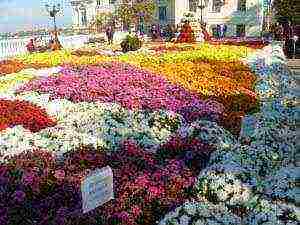
Chrysanthemum in landscape design
- Timely loosening of the soil
- Application of fertilizers of organic and mineral origin before flowering
Watering for a plant is required only during the hottest days, with a long absence of natural watering in the form of rains and during the period of the most active development of the plant.
But even in this case, it is not worth adding a large amount of liquid. This is because the chrysanthemum is very drought tolerant.
For tall plants, a garter to specially prepared pegs is imperative.
It is also worth removing wilted inflorescence baskets, as this significantly prolongs the flowering period of the bush.
For the full development of girl's chamomile, it is necessary to remove weeds and wilted inflorescences, loosen the soil, apply the required amount of fertilizer at the right time and water on especially hot days.
While watching the video, you will learn about the cultivation of chrysanthemums.
Chrysanthemum maiden is a useful perennial plant that does not require special care. Despite this, the plant can be a wonderful decoration for any site and flower garden, so you should definitely get a beautiful snow-white shrub.
Garden flowers
The maiden chrysanthemum is a perennial plant that is grown as an annual. The photo of the flower resembles a picture of snow flakes, which is why it is known as "snow balls".
The plant can be described as follows:
- Reaches 25 cm in height.
- Large marginal flowers are collected in round inflorescences-baskets.
- The cut, lush leaves are light green or yellowish in color.
- Seeds are white or cream colored, very small. 1 g contains about 5000 seeds.
Due to its exotic nature, the plant is often used in the manufacture of flower arrangements. Looks good in combination with heliotrope, salvia or marigolds. After cutting, they do not fade for a long time. Also used when decorating flower beds without any additional colors.
Chrysanthemum is sown in May, when the main frosts have already passed. A site for sowing is chosen in the open sun. Flowers prefer calcareous, fertile and well-drained soil.
When planting, the seeds are deepened 3 mm into the soil. After planting, watered abundantly. After a month, you can see the first flowering. Chrysanthemum requires constant care:
- Water the flowers as the soil dries. In hot and dry weather, watering should be increased.
- Before flowering, the plant requires 3 additional fertilizing with complex mineral fertilizers.
- Almost the only pest of chrysanthemum is aphid. When it appears, the affected bushes are removed. Other diseases rarely appear, they are treated with special plant medicines.
- To achieve the appearance of additional peduncles, plant pruning is done.
- Maintain loose soil at all times.
- Remove weeds as they appear.
- In areas with not cold mild winters, chrysanthemum can be kept as a perennial.
Keep in mind that the plant has an extremely strong characteristic odor, so choose an area for growing it that is not point-blank to the living area.
Thus, the maiden chrysanthemum is an ornamental plant that is grown to decorate flower beds and make bouquets. There are no problems with breeding it, but certain care nuances need to be known and performed regularly.
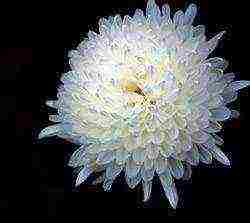 Among the huge variety of luxurious flowers, the perennial chrysanthemum occupies a special place. "Queen of Autumn" - this is how sophisticated breeders and lovers of bright colors and magnificent forms speak of her. Today we will talk about what varieties and varieties of perennial chrysanthemums are found, how best to care for these colorful pets. Photos of magnificent chrysanthemums will help you enjoy the riot of colors and choose varieties.
Among the huge variety of luxurious flowers, the perennial chrysanthemum occupies a special place. "Queen of Autumn" - this is how sophisticated breeders and lovers of bright colors and magnificent forms speak of her. Today we will talk about what varieties and varieties of perennial chrysanthemums are found, how best to care for these colorful pets. Photos of magnificent chrysanthemums will help you enjoy the riot of colors and choose varieties.
Chrysanthemums: varieties and varieties
It is not in vain that they say about perennial chrysanthemums that they inspire optimism in a convinced pessimist. After all, these lush and fragrant flowering plants can make bright not only a personal plot, but also the life of a gardener who grows picturesque plants and horticultural crops.
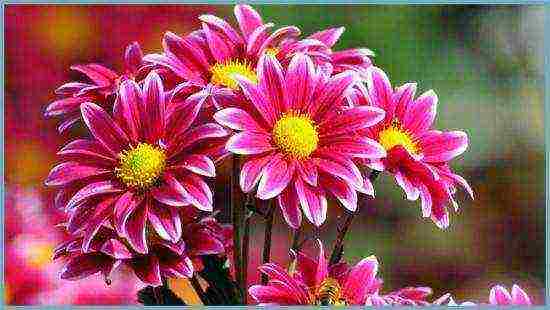
Chrysanthemums can be completely unusual and bright colors.
Every time you buy a bag of an unknown variety, you are amazed at the duration of its flowering, the magnificent colors, the height of the plant, the shape and texture of the petals, as well as the degree of their doubleness.
Breeders divide chrysanthemums into:
- simple forms;
- large-flowered;
- terry.
There is also a gradation in color, flowering periods, flower size and decorativeness. Many subspecies of chrysanthemums are intended only for subsequent cutting and making bouquets - these are the so-called bouquet chrysanthemums. Their height can vary from 15 to 150 cm. Such a wide range allows you to decorate entire flower beds with a variety of cultures, which will bloom and delight the eye at different times - from mid-June to the first snowfall.

Chrysanthemum flowers of various shapes and sizes
As for the color of the buds, it is impossible to immediately list all the colors and shades. There is an unthinkable number of colors that excite the imagination: white and lemon, orange and purple, crimson red, lilac and emerald.
The historical homeland of chrysanthemums is Northern China, where residents were actively engaged in the selection of this amazing and, fortunately, unpretentious garden culture. Thanks to the merits of professional breeders, today it is possible to grow chic varieties of perennial chrysanthemum with excellent consumer properties.
The most widespread and well-known variety - "Early Yellow" is close in decorativeness to Japanese anemones. Today there are about 700 varieties of these garden plants.
- Very popular bush chrysanthemums, which are equally suitable for arranging the landscape of the garden, and for cutting.
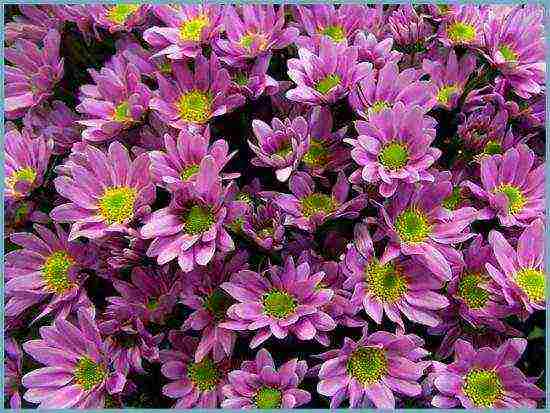
Bush chrysanthemums
- Also meet feathery double flowers with a very dense and lush planting of petals. Due to this, they take the shape of a ball, completely covering the flower bed.
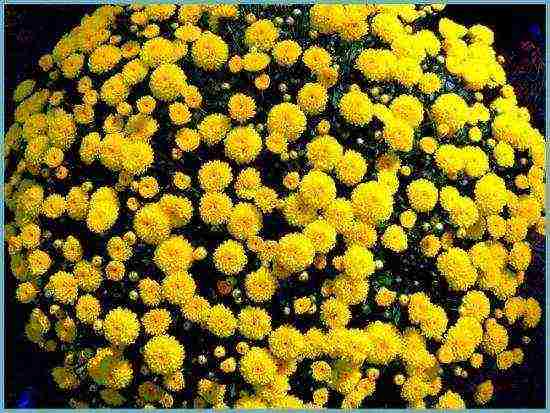
Terry chrysanthemums
- Bristly chrysanthemums attract attention with their thin and slightly twisted petals, which outwardly resemble graceful brushes.
- Pompon varieties chrysanthemums boast an ideal spherical shape. Dense terry, bright colors and long flowering in any growing conditions are the undoubted advantages of this variety.
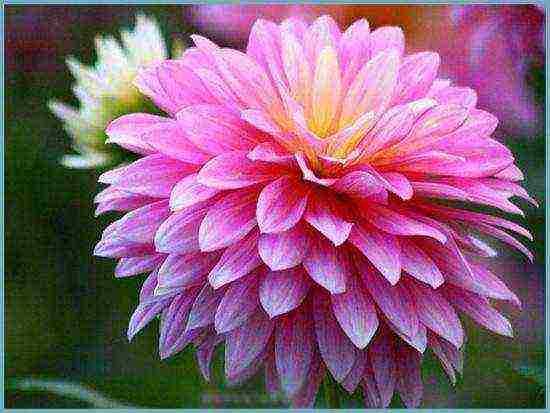
Pompom chrysanthemums
- Semi-double varieties include a great variety of shapes, colors and structures. A prominent representative of this group is a garden plant with slightly drooping inflorescences. Their middle is almost not closed, and along the edges there are petals of the most unexpected shades and shapes.
- Simple varieties are represented by very graceful and at the same time uncomplicated inflorescences, outwardly resembling a garden chamomile in shape.
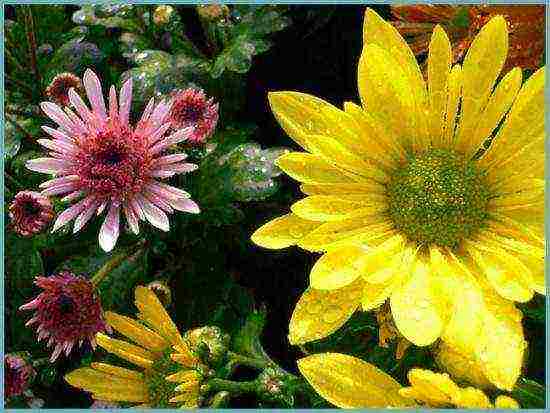
Simple varieties
- Perennial chrysanthemums anemone-like varieties easy to recognize by the simple shape and slightly convex heart of the inflorescence. It seems to rise above the petals and reach for the sun. These are the most delicate representatives of garden chrysanthemums, which smell pleasantly and create a good impression.
- Spoon-shaped chrysanthemums belong to rare varieties.Already by the name, one can understand that the flowers are somehow magically connected with spoons. The thing is that the shape of each petal resembles a teaspoon.
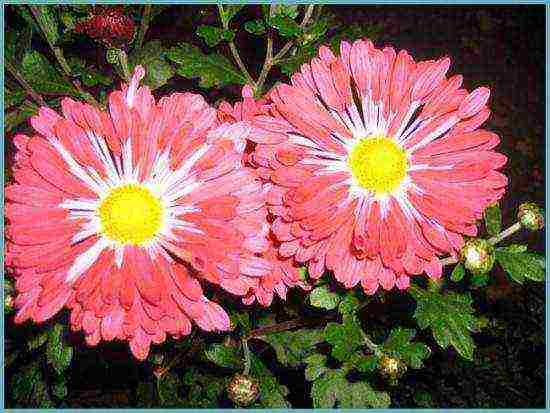
Spoon-shaped chrysanthemums
Chrysanthemums: planting and care in the open field
Perennial chrysanthemums do not like darkening and high humidity very much, so it is better to plant them on a small hill and in a sunny place. This will save you from pulling shoots, changing the time and duration of flowering.
Attention! Chrysanthemums have a superficial root system, so overdrying the soil is unacceptable!
For planting, it is recommended to use a very loose and moisture-permeable soil with sufficient nutrient content. If the soil is too dense, it is recommended to mix it with peat or compost. To improve drainage qualities, you can use coarse sand and fine gravel.
Attention! Garden chrysanthemums, which are not labor intensive to grow, prefer a neutral potting mix.
A cloudy, or even better rainy day is chosen for planting. A hole up to 40 cm deep is watered abundantly, drainage is done. Then a chrysanthemum is placed and lightly sprinkled with earth.

Chrysanthemum thrives in the shade of trees
Attention! The plant should not be deeply buried, because the root system grows parallel to the ground.
If low-growing varieties will be grown, then you need to worry about additional support in advance.
A couple of days after planting, you can remove the growth point on the culture. After another 3 weeks, the tip of the shoot is neatly broken off.
Advice! After planting the plant in the ground, shade it using a non-woven material. Make sure that it does not touch the leaves of the plant.
Plant care
When growing garden chrysanthemums on a garden plot, it is important to remember that watering should be moderate, otherwise the plant will rot from an excess of moisture. An exception, perhaps, can only be a very dry and hot period.
Attention! Lack of moisture can lead to woody plant stems and loss of decorative effect.
Further care for your perennial garden culture will not take much of your time. Regular watering, thorough loosening, timely feeding and spraying from various parasites are all the activities that will be required for the full growth and colorful flowering of the chrysanthemum.
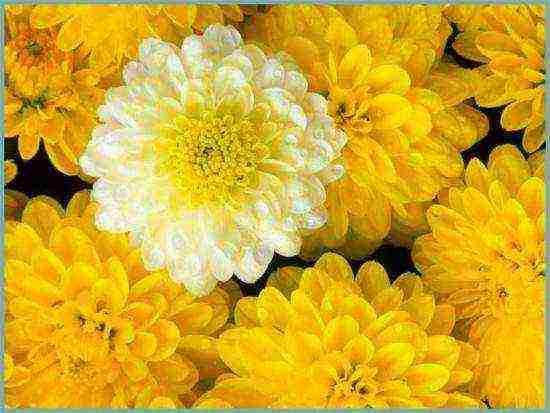
The moisture balance in the soil is very important for the crop.
You need to take special care of the culture closer to cold weather and frost (end of October). Despite the fact that chrysanthemums tolerate low temperatures well, it is better to build a frame for them with a film coating. Such a simple measure will allow you to admire the bright colors and lush flowering of delicate flowers for another month. The frame can be removed by December, and the bushes can be planted in pots and placed on the windowsill in a bright veranda, where the chrysanthemum will bloom until January.
Fertilizing and feeding chrysanthemums
The plant is fed weekly with mullein infusion in a ratio of 1: 10. Lush blooms can be obtained by introducing a balanced amount of phosphorus and potassium fertilizers into the soil, and the green mass can be increased using fertilizing based on nitrogen.
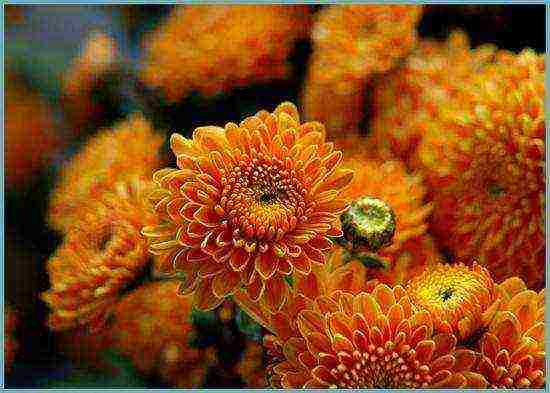
The more often you feed the chrysanthemum, the more lush and longer it will bloom.
Attention! At the time of fertilization, it is important to ensure that the fertilizing does not fall on the leaves and cause them to burn! It is better to under-feed the plant than to burn it!
Plant propagation
Breeders recommend propagating a perennial crop only by cuttings and dividing the bush, since the seeds often do not preserve the variety.
Attention! Reproduction is best done in late spring (in May), when the probability of frost is minimal. The beginning of summer is also a good period for replanting the plant.
If you have material for planting only closer to autumn, then have time to plant it before mid-September so that the first frosts do not break the spirit of the plant. Otherwise, the seedling can be transplanted into a wide, but (very important!) Shallow pot, having previously cut it low.
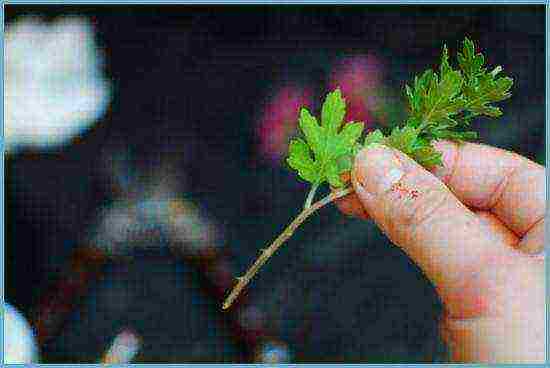
Chrysanthemum reproduces well by cuttings
The container with the planted chrysanthemums is placed in a dark place (it can be a loggia or a terrace), where the temperature is kept at a constant level of 4-6 ° C. Throughout the winter period, it is necessary to maintain an optimal level of soil moisture.
At the end of winter, the bushes can be planted in a greenhouse or flower greenhouse, where they should be watered as often as possible. By the end of March, when the shoots have grown a little, you can cut the cuttings and carefully plant them in a box with a mixture of soil, humus and sand, then cover them tightly with a sheet of glass. A month later, when the cuttings take root, they can be planted in wider containers, and then in open ground.
Diseases and pests
Since a great many different microorganisms live in any soil, the plant periodically needs to be treated with special preparations that will reliably protect against diseases and pests, root rot. Abundant watering will keep the crop from mites and aphids that cannot tolerate moisture. The bush chrysanthemum Ratibor, Aktara, Fitovermi and other preparations will save from snails, leaf rollers and caterpillars.
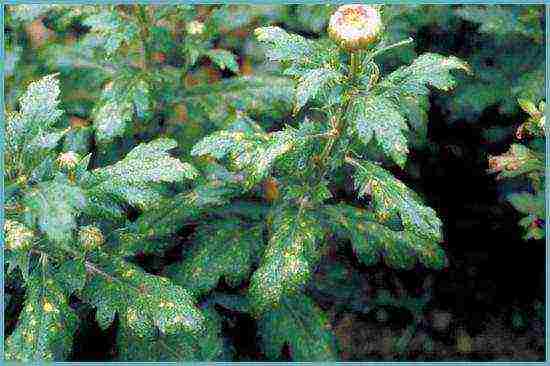
White rust
Shrub chrysanthemum: combination with other plants
Perennial garden culture goes well with fruit trees (it can be rowan or wild apple). A good combination is given by raspberries growing nearby, sea buckthorn, barberry. Shrub chrysanthemum looks incredibly attractive in the company of decorative leafy plants - hydrangea, ivy, wild grapes, lemongrass.
The chrysanthemum looks charming and gentle surrounded by tall perennial plants: dahlia, shrub aster, asparagus and other plants.

Chrysanthemums in landscape design
Shrub chrysanthemums in landscape design
Lush and bright chrysanthemums are the perfect decoration for any garden and site. With the participation of these plants, you can get luxurious flower beds and mixborders, with the help of them glades and lawns are decorated. Among the bright emerald greenery, shrub chrysanthemum makes up expressive spots of orange, purple, lilac color. Almost all varieties of shrub chrysanthemum are suitable for a spectacular landscape design.
How to grow a chrysanthemum: video
Types of chrysanthemums: photo
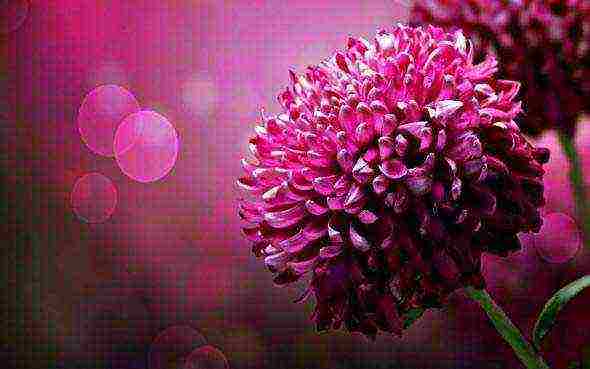
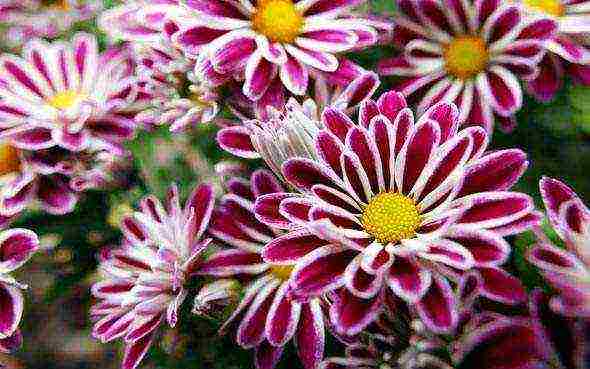
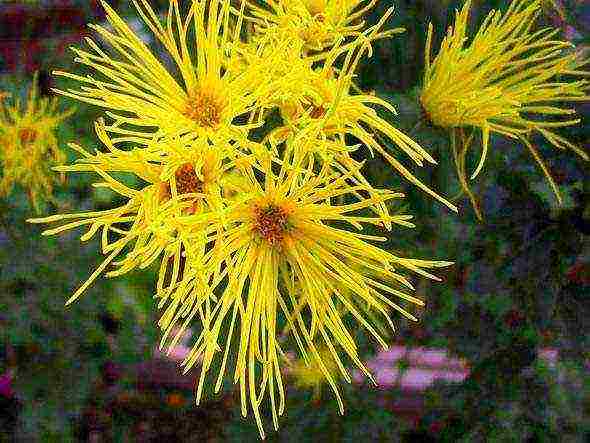

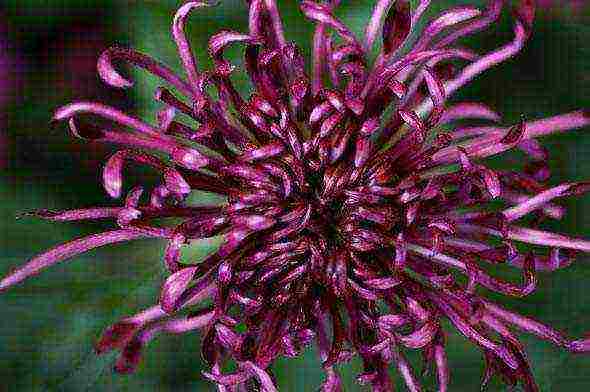
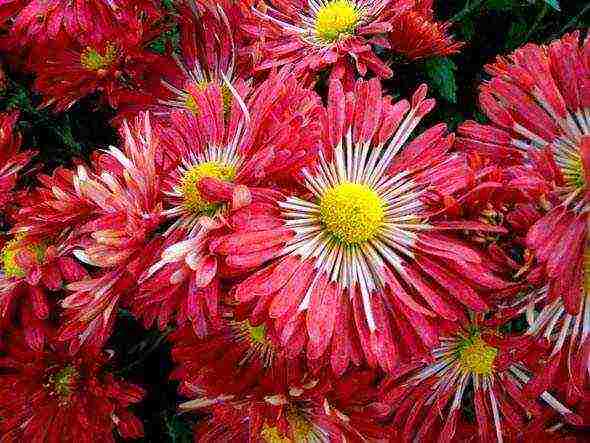

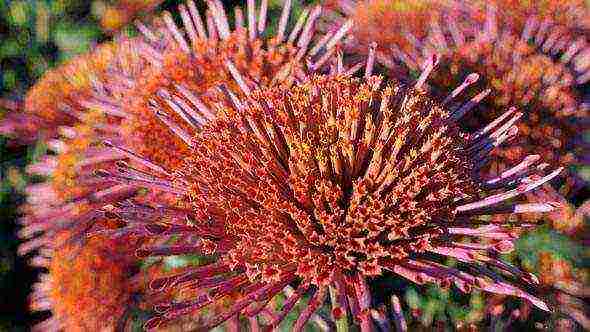
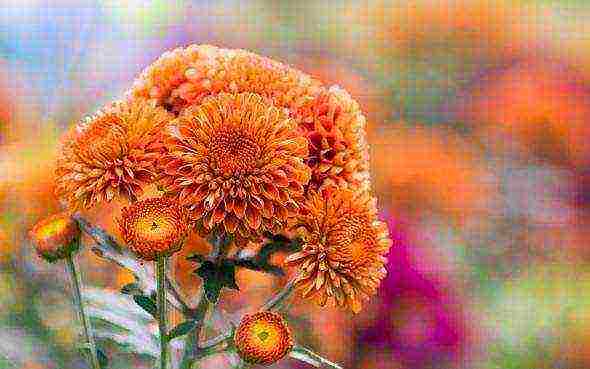
Eastern wisdom advises everyone who wants to live a happy life to grow
chrysanthemums
... According to an ancient Chinese legend, the white dragon tried to encroach on the sun itself. He tore it with teeth and claws, and sparks fell to the ground and turned into yellow flowers, which were later called chrysanthemums. They are depicted on the Japanese coat of arms, coins and seals, which does not bother Asians
cook with chrysanthemums
cakes and salads. As a garden flower, chrysanthemum has been known for three millennia, but interest in it is only growing.
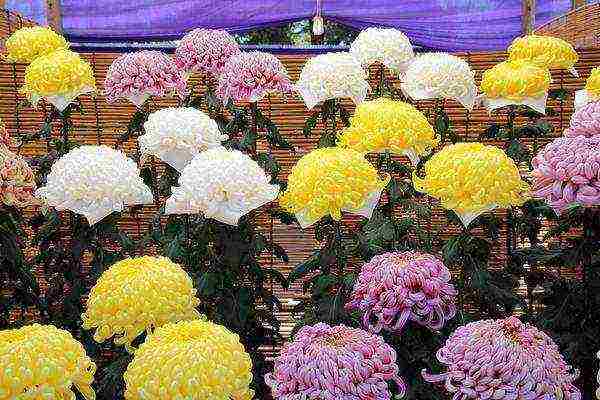
Breeders are constantly striving to get as large-flowered varieties as possible, but gardeners are more attracted to small-flowered Korean chrysanthemums, since they are resistant to low temperatures, are good outdoors in combination with other flowers, have high decorative qualities, bloom for a long time and profusely almost until November ... Therefore, it is not for nothing that chrysanthemum is considered the queen of autumn. In addition, it is grown in pots to decorate houses, and in cut form, it lasts for a long time - up to 30 days, so it is ideal for bouquets.
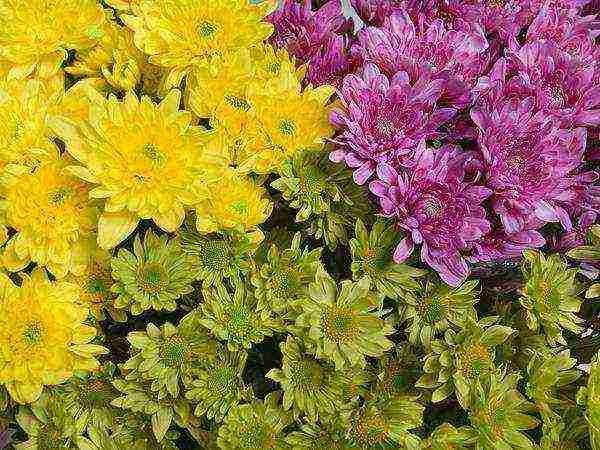
In the open field, chrysanthemum blooms in August and pleases with its lush flowers all autumn, withstand frosts down to -7 ° C. Depending on the variety, the stems reach a height of 30-80 cm and are decorated with double, semi-double and simple inflorescences of unusually diverse shades.
In the northern regions of Russia, it is believed that it is impossible to grow chrysanthemums outdoors, but in fact, they can successfully winter with light
hideouts
in central Russia and even in Siberia! In these areas, after cutting the stems, hemp hemp 10-15 cm high is well spud
peat
, cover with foliage and insulate
spruce branches
.
Planting chrysanthemums
Chrysanthemums do not like the slightest shading and moisture retention, so the place for them should be sunny and at least slightly elevated. This is a guarantee that the shoots will not stretch, change the time and period of flowering. However, the root system of chrysanthemums is superficial, so the soil should not be overdried either.
The ideal soil for them is loose, moisture-permeable, with an optimal amount of various nutrients. With dense and low-fertile soil in the garden, a little peat, compost or rotted manure is introduced into the soil before planting cuttings, but do not abuse them, otherwise the plants will be too tall to the detriment of flowering. Add a small amount of coarse sand to the soil for drainage. The soil mixture is preferably neutral or slightly acidic.
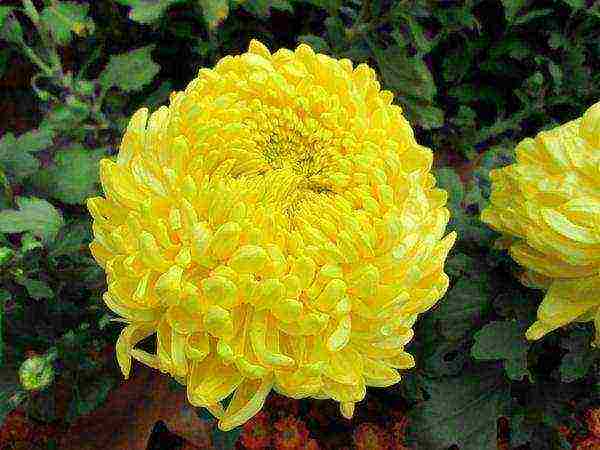
The ideal day for planting is cloudy or rainy. In hot, sunny weather, plant cuttings in the early morning or late evening when the sun is less active. Pour holes 35-40 cm deep with plenty of water, put drainage, earth mixed with vermicompost in a ratio of 20: 1. Chrysanthemum is placed and covered with earth. The roots grow parallel to the soil, so they are not buried too deep. For tall varieties, additional support is needed.
Immediately after planting in the ground, the first pinching is carried out - the growth point on the plant is removed. 3 weeks after planting, break out the upper part of the shoot with 2-3 nodes - the second pinch. The first days after planting, artificially shade the seedlings so that they do not suffer from bright sunlight. The best option is a non-woven fabric, but it is advisable that it does not come into contact with the leaves.
Reproduction of chrysanthemums
Since varietal characteristics are not preserved when propagated by seeds, chrysanthemums are propagated
cuttings
, dividing the bushes or root shoots, which are separated from the mother bush.
In any case, it is necessary to plant and transplant chrysanthemums. in the spring, in May, when frosts and cold snaps pass. It is also acceptable at the beginning of summer - this will not affect the development of chrysanthemums.
In the next video, you can see the process of reproduction of chrysanthemums by dividing the bush in the spring.
If you got hold of the planting material closer to autumn, then plant it in the ground
until September 15 , so that before the onset of frost, the plants have time to take root well. If you did not have time during this period, then plant the seedling in a shallow wide pot, cutting low. Send the container with chrysanthemum to a dark place to a warm loggia or a heated terrace, where until spring the temperature will be at the level of 4-6 ° C - these are the optimal conditions for the successful development of plants. Moisten the ground periodically throughout the winter.
From the end of February, chrysanthemums are planted in a greenhouse and watered more often. By the end of March, the shoots will grow back, and it will be possible to do cuttings - cut off the shoots no more than 10 cm.
Carefully plant the cuttings in a box filled with a mixture of earth, sand and humus in a 1: 2: 1 ratio, close tightly with glass. After a month, the cuttings will take root, they can be planted in wide containers. As soon as the danger of an unexpected cold snap passes, it will be possible to transplant the mother plant and seedlings into the ground.
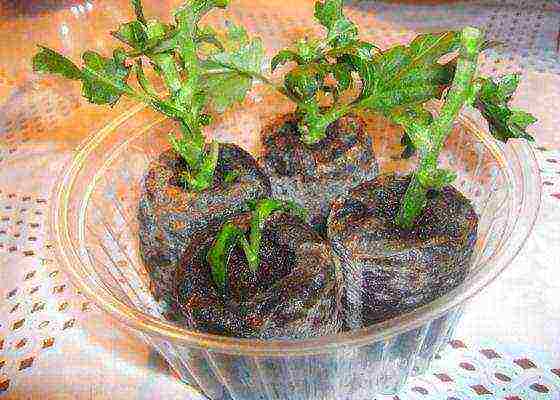
Chrysanthemum care
The watering regime should be moderate, in which the root system will not rot from excess moisture. This is despite the fact that chrysanthemum is quite hygrophilous. The exception is the dry period (during which water more abundantly, so that the stems do not become rusty, and the flowers do not lose their decorative effect) and the period before flowering. It is better to take water standing or rainwater.
Once a week "feed" the flowers with mullein infusion (1:10), and before budding -
potash
and
phosphorus fertilizers
for lush bloom, sometimes
nitrogen
for building up green mass. Discard top dressing before flowering. During dressing, make sure that the fertilizer solution does not get on the leaves and cause burns.
Water only at the root .
For the development of young chrysanthemums, it is extremely important to ensure a balanced diet in the first two months, as the green mass is growing very actively. Burnt mullein and chicken droppings are very effective. The main rule is that it is better not to feed the plant than to burn it.
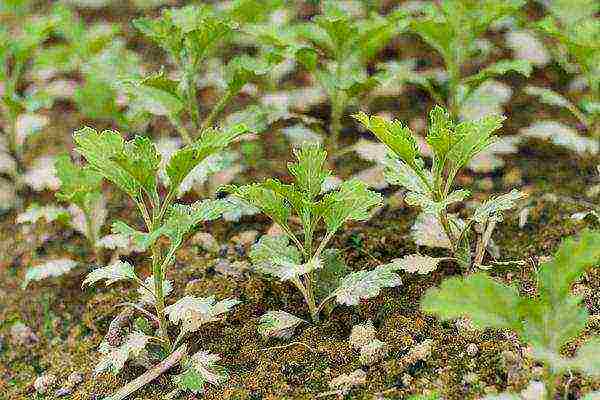
- Pour a couple of buckets of mullein or a bucket of chicken droppings into a large container, fill it with water, stir and let it infuse for three days - during this time the valuable highly concentrated fertilizer will be ready.
- Prepare a solution: add 10 liters of water to 1 liter of concentrated infusion.
- Apply 1 liter of solution under each plant only at the root and always on wet soil.
Further care for the chrysanthemum does not require much effort - regular watering, loosening, weeding, spraying from parasites.
Despite the fact that chrysanthemums tolerate the cold quite well, at the end of October, protect the flower bed from frost by placing a frame with plastic wrap on it - and you will admire the flowering of April cuttings for another month. You will remove the frame at the end of November, transplant the bushes into pots, and they will bloom on a warm, bright veranda even in January.
If you have recently been given a potted chrysanthemum, how to keep it until spring and planting in the garden, you can find out from the answer to the question "How to keep chrysanthemums until spring?" And the article The second life of a chrysanthemum from a bouquet is confirmation that a flower you like can be propagated by cuttings, even if you do not know the exact date of cutting.
Disease and pest control
Water-loving chrysanthemum, abundant watering, especially in the absence of rain, helps prevent the defeat of aphids and mites that cannot tolerate moisture.
Many harmful microorganisms and pathogens live in the soil.
diseases
, so after every rain, treat the plants with drugs for diseases (for example, Quadris or Previkur). Protects from root rot
Fitosporin
, it can be added to the irrigation water with every feeding.
Of all the enemies of chrysanthemums (leaf rollers, snails, aphids, ticks, etc.), caterpillars are the most dangerous. Only one of them can eat several buds per night. So keep your ears open, review your plantings regularly and take action on time. Good preparations for fighting insects are Aktara, Aktellik, Ratibor, Iskra, Fitoverm, etc.
Types and varieties of chrysanthemums
The genus of chrysanthemums has more than 150 species, but in our garden they grow mainly their hybrids. The classification of chrysanthemums is quite complex. There are main garden groups of hybrid chrysanthemums:
- Korean (small-flowered, inflorescence 2-9 cm),
- Indian (large-flowered, inflorescence 10-25 cm),
- Chinese and Japanese.
By the structure of the flower varieties are divided into the following groups:
- simple,
- semi-double,
- anemone,
- terry,
- flat,
- hemispherical,
- spherical,
- curly,
- pompom,
- radial.
By the structure of the petal distinguish tubular and reed. For growing in the garden, the most popular chrysanthemums are Korean, they are unpretentious, beautiful, bloom for a long time. Large-flowered species are usually grown for cutting and arranging bouquets. Here are some popular small-flowered varieties for your garden.
Chrysanthemum Korean Alyonushka
Bright pink non-double inflorescences 5-6 cm in diameter. Bush up to 50 cm tall. Blooms in September.
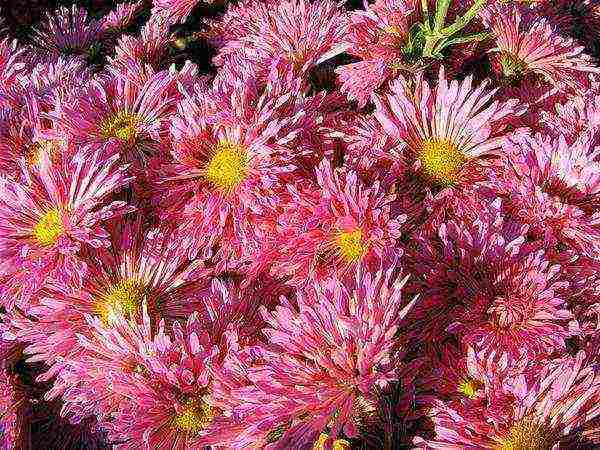
Chrysanthemum Korean dune
Small orange-yellow flowers, 5 cm in diameter. The height of the bush is 60 cm.
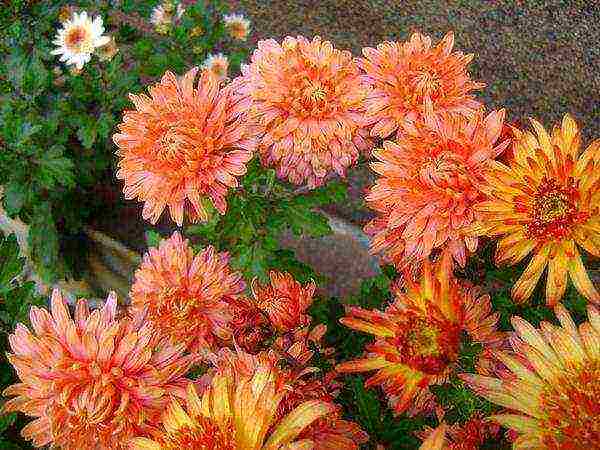
Chrysanthemum Korean Snowball
Terry inflorescences, small, 56 cm in diameter, white with slightly pink tips. Bush up to 60 cm high.
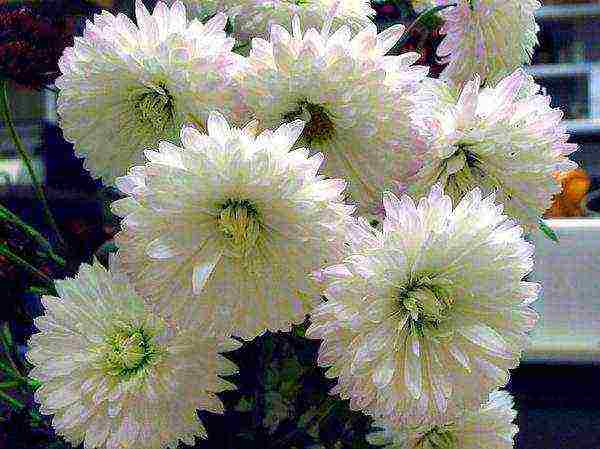
Korean chrysanthemum Mishal
Small-flowered terry chrysanthemum, inflorescences 4-4.5 cm, pompom, lush, bright yellow. Blooms from September. Bush up to 40 cm high.
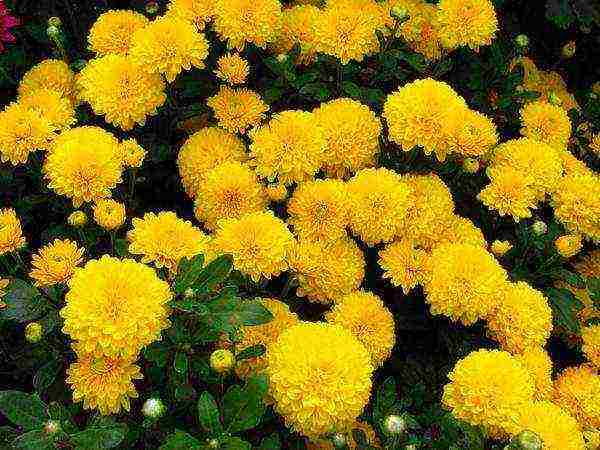
Chrysanthemum Korean Terracotta
Terry flowers, 5-6 cm in diameter, orange shades. The bush is 50-60 cm tall.
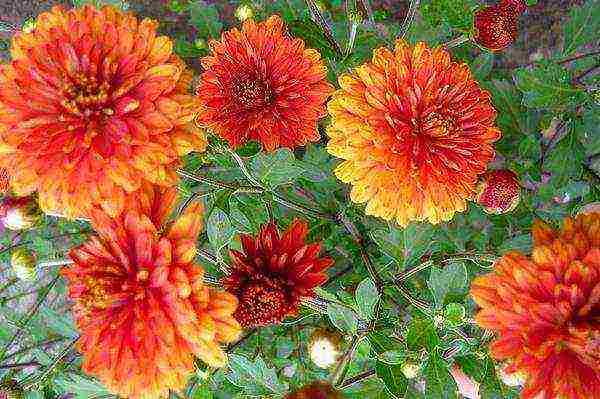
Chrysanthemum bush Saba
A very original color of chrysanthemum with a yellow-green core and reddish-lilac sharp petals with a white border. The diameter of the flower is 5 cm, the height of the bush is 60-70 cm.
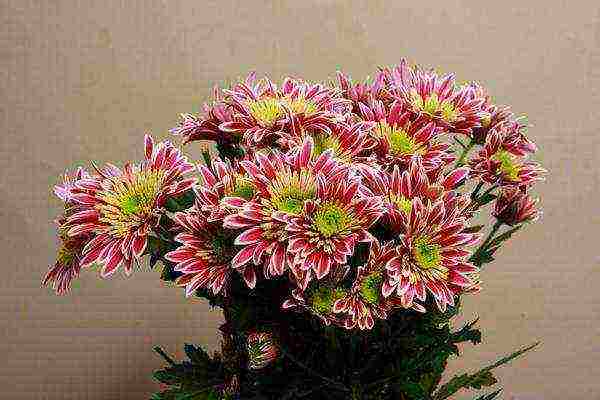
You can get acquainted with the recently fashionable variety series of large and small-flowered chrysanthemums by reading the publication
"Families" of chrysanthemums
.
Read more about chrysanthemums on our website:
- Chrysanthemum - a flower of longevity and transience of life
- The love story of the Japanese for chrysanthemums
- Chrysanthemum Legends
- Chinese chrysanthemums - the charm of antiquity
- Chrysanthemums of the Nikitsky Botanical Garden (very beautiful photos and descriptions of varieties)
- 8 queens of balls of chrysanthemums of Nikitsky botanical garden
- 17 personalized chrysanthemums of the autumn ball
- Old chrysanthemums in new optics
What chrysanthemums grow in your garden?
